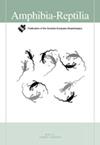Evidence of morphological homoplasy among large, semi-aquatic species of Desmognathus
IF 1.3
4区 生物学
Q3 ZOOLOGY
引用次数: 0
Abstract
The salamander family Plethodontidae is replete with instances of repeated homoplasy. We tested for morphological homoplasy in distantly related species of the plethodontid genus Desmognathus that share similar ecologies. Specifically, we compared species that are large and nearly aquatic. Using morphometric analyses, we compared the respective morphologies of four large, nearly aquatic forms, specifically the Black Mountain Salamander (Desmognathus welteri), the Dwarf Black-bellied Salamander (D. folkertsi), and two phylogenetically divergent lineages of the Black-bellied Salamander (D. quadramaculatus). Morphometric analysis uncovered distinct differences among them. However, all of the large-bodied lineages exhibited the same extent of tail-fin development in spite of D. welteri’s closer phylogenetic relationship to smaller, more-terrestrial species than to the other large, nearly aquatic forms we tested. We hypothesize that large body size is also a consequence of aquatic adaptation. These morphological consequences of a nearly aquatic ecology represent another case of homoplasy within this salamander family.大的,半水栖种的形态同源性的证据
蝾螈科多齿螈科充满了重复同型繁殖的实例。我们测试了具有相似生态的远缘多齿兽属物种的形态同源性。具体地说,我们比较了大型和接近水生的物种。利用形态计量学分析,我们比较了四种大型的近水生形态,特别是黑山蝾螈(Desmognathus welteri)、矮黑腹蝾螈(D. folkertsi)和两个系统发育上不同的黑腹蝾螈(D. quadramaculatus)。形态计量学分析揭示了它们之间的明显差异。然而,所有的大型动物谱系都显示出相同程度的尾鳍发育,尽管与我们测试的其他大型的、接近水生的物种相比,韦氏裂尾龙与较小的、更陆生的物种有着更密切的系统发育关系。我们假设体型大也是水生适应的结果。这些几乎水生生态的形态学结果代表了这一蝾螈家族内同质性的另一个例子。
本文章由计算机程序翻译,如有差异,请以英文原文为准。
求助全文
约1分钟内获得全文
求助全文
来源期刊

Amphibia-Reptilia
生物-动物学
CiteScore
3.10
自引率
6.20%
发文量
39
审稿时长
6-12 weeks
期刊介绍:
Amphibia-Reptilia is a leading European multi-disciplinary journal devoted to most of the aspects of herpetology: ecology, behaviour, evolution, conservation, physiology, morphology, paleontology, genetics, and systematics.
Amphibia-Reptilia publishes high quality original papers, short-notes, reviews, book reviews and news of the Societas Europaea Herpetologica (SEH). The Societas Europaea Herpteologica (SEH) website is located at: www.seh-herpetology.org.
 求助内容:
求助内容: 应助结果提醒方式:
应助结果提醒方式:


